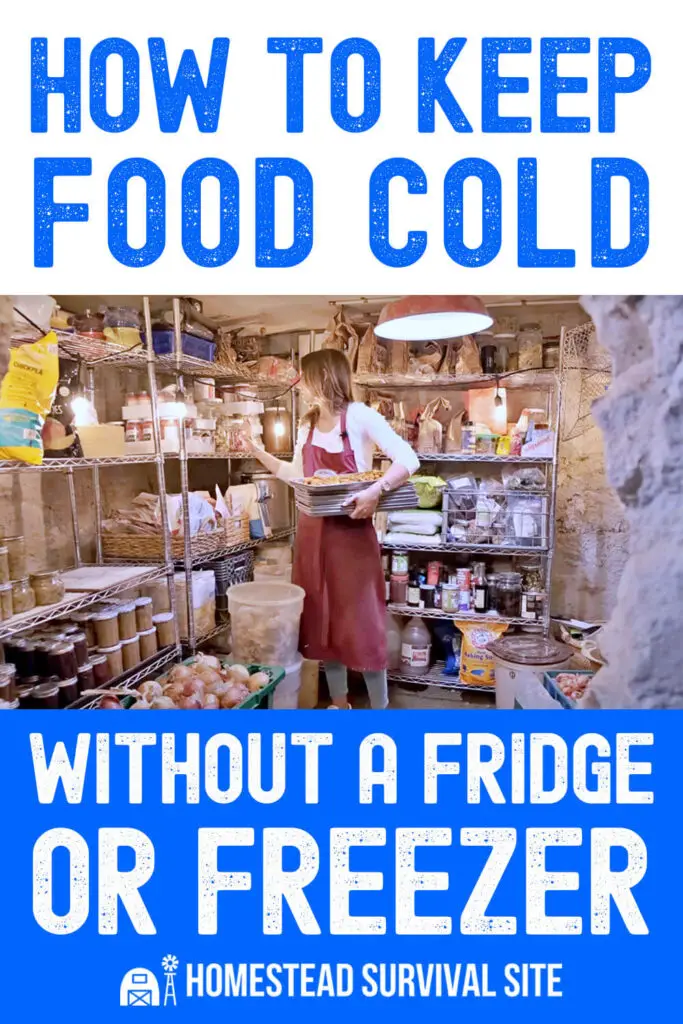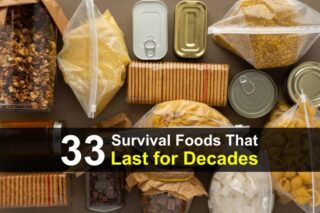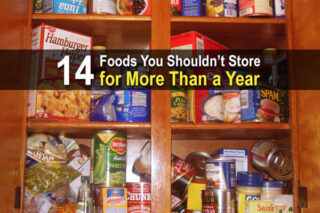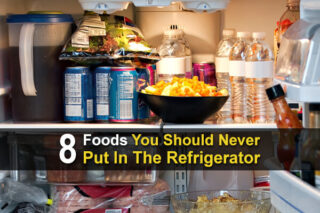Estimated reading time: 16 minutes
The whole concept of refrigeration and freezing of food is a relatively new idea. The invention of electrical power generation made it all possible and even in the early part of the 20th century, many people lived without the luxury of a refrigerator or freezer.
That’s all changed and now a refrigerator/freezer is as common in the kitchen as a car in the garage. But how often have we been suddenly stumped about what to do with the foods in the fridge when the power suddenly goes out during a summer storm?
The good news is that the average outage is measured in hours, but even then, foods can be subject to spoilage, especially if someone decides to ponder the shelves of an opened and unpowered refrigerator for a few minutes.
Want to save this post for later? Click Here to Pin It On Pinterest!
How Long Will Food Last in An Unpowered Refrigerator or Freezer?
According to the U.S. Department of Agriculture (USDA), foods will last up to 4 hours in an unpowered refrigerator and 48 hours in a full freezer.
After that, food spoilage potential increases. They have a chart and a downloadable PDF that identifies food spoilage rates as well. If you think about it, that’s really not much time, and that’s just in the short-term.
What’s the Worse That Could Happen?
Long-term loss of electricity is the most common reason people lose the ability to continue to refrigerate or freeze foods, at least with conventional refrigerators or freezers.
The events that could lead to a long-term loss of power tend to be catastrophic, from widespread natural disasters to war or something out of the movies like an electro-magnetic pulse or asteroid strike taking out the power grid and a whole lot more.
There’s also a lifestyle decision that people make to simply live off-the-grid. Most of those folks anticipate how they will improvise refrigeration or freezing, and many have learned to limit foods that require refrigeration or freezing in the first place.
It’s interesting that many people who live off the grid say that refrigerating and freezing food is their greatest concern and their greatest challenge. We’ll cover some of their solutions below.
- How Long Will Food Last in An Unpowered Refrigerator or Freezer?
- What’s the Worse That Could Happen?
- Improvised Refrigeration is Easier than Freezing
- Is Anything Safe?
- Food-Safe Temperatures
- Bacteria Are Everywhere
- What Common Bacteria Affect Food?
- Why Do We Refrigerate and Freeze Foods?
- Common Food-Borne Illnesses
- There are Food Exceptions
- Improvising Refrigeration and Freezing
- What About Solar?
- Will You Ever Need to Do This?
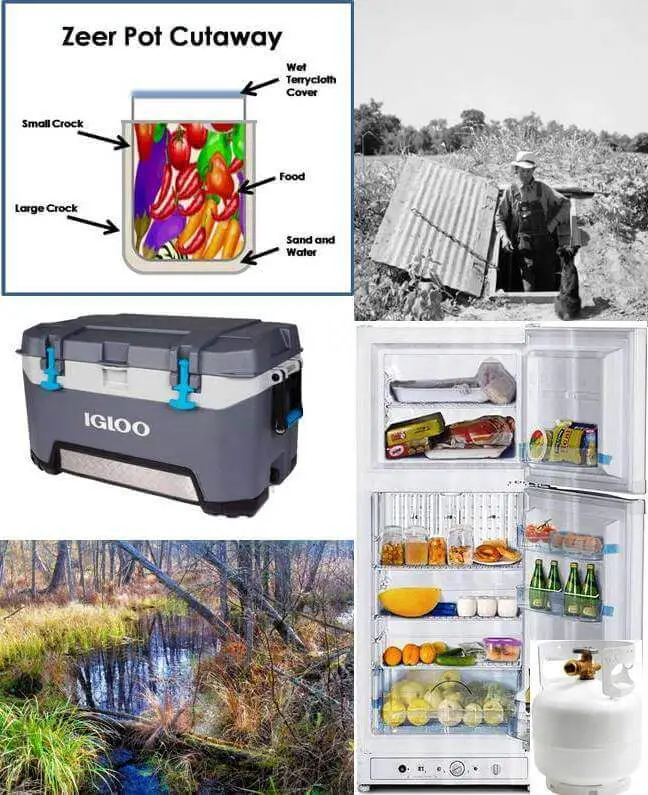
Improvised Refrigeration is Easier than Freezing
It’s easier to keep something refrigerated than it is to freeze it if there’s no electricity. There are ambitious solutions like propane-powered refrigerators and freezers, but that would require a regular supply of propane. If you have access to a steady or very large supply of propane (and can afford it), that may be the simplest solution.
They can be expensive, but if you can salvage one from an old RV or boat, it would be not only affordable but a good idea just to have in storage and on reserve –just in case. On average, a propane refrigerator/freezer uses an average 20-pound tank every 2 weeks.
Is Anything Safe?
There are some surprising exceptions to the constant need for refrigeration or freezing. It should be noted that freezing is typically a long-term approach to food preservation, especially for meats and seafood, while refrigeration is allows food to essentially “hold” while kept at a steady and regular temperature.
Food-Safe Temperatures
The USDA has identified a range of 40º F. to 140º F as the food danger zones. These are the temperatures where bacteria and mold have the potential to develop and multiply. Temperatures below 40º F and above 140º F either inhibit or prevent the growth of bacteria. And it’s important to understand the meaning of “prevent.”
Bacteria Are Everywhere
It’s rare than any food finds its way home without some level of bacteria present. In some cases, cooking kills the bacteria and in other instances, washing things like fruit or vegetables removes them. One common technique is to swirl green, leafy vegetables in a bowl of vinegar before rinsing to kill or remove any pathogens adhering to the leaves.
Regardless, refrigeration and freezing is often a step towards “preventing” the further growth and spread of the bacteria already present on or in food.
What Common Bacteria Affect Food?
There’s no easy answer. They number in the thousands but they fall into two general categories. Both are bad: pathogenic bacteria, the kind that cause food-borne illness, and spoilage bacteria, the kind of bacteria that cause foods to deteriorate and develop unpleasant odors, tastes, and textures.
Pathogenic bacteria can grow rapidly in the “Danger Zone,” the temperature range between 40 °F and 140 °F. Because they do not generally affect the taste, smell, or appearance of a food, one cannot tell that a pathogen is present.
But this isn’t just about unrefrigerated foods. Spoilage bacteria can grow at cold temperatures, such as in the refrigerator. Eventually they cause food to develop off or bad tastes and smells. Most people would not choose to eat spoiled food, but if they did, they probably would not get sick.
However, some bacteria such as listeria monocytogenes thrive at cold temperatures, and if present, will grow in the refrigerator and could cause illness.
Why Do We Refrigerate and Freeze Foods?
The obvious answer is to avoid contamination from bacteria and mold. Curiously, it was bacteria and mold that led to the creation of cheese, fermented foods like sauerkraut and Kim Chee, and even wine and beer.
Back in a time without refrigeration or freezing, many people were desperate and willing to eat foods that appeared spoiled only to discover the surprising tastes of these new and evolved foods. But there’s a big caution.
The types of bacteria or molds that successfully create foods like cheese or fermented foods are safe and benign exceptions, but actually are very rare. Most bacteria and some fungi that affect foods will make you sick or worse. Food-borne illnesses are notorious and often make the headlines.
Common Food-Borne Illnesses
- Salmonella
- Listeria
- E Coli
- Botulism
- Mold
There are Food Exceptions
Contrary to popular belief, there are some foods that don’t require the level of refrigeration that we typically apply. We’ll mention the very conservative USDA recommendations, but in some parts of the world, food handling and storage is not as strict depending on the type of food.
Eggs
In Europe and Asia, eggs are not refrigerated. But there’s a difference in how they’re handled versus the U.S. In many parts of the world, eggs are not washed after harvesting. This retains the cuticle which is a thin membrane surrounding the egg that prevents bacterial contamination (particularly Salmonella) from penetrating the egg shell.
As a result, eggs are sold unrefrigerated and can last up to 21 days. The eggs are sometimes washed before cooking, but usually the egg is simply cracked or dropped intact into boiling water.
In the U.S. and some other countries, eggs are washed after harvest and as a consequence, they require immediate refrigeration. They can last up to 45 days refrigerated, but according to the USDA, a washed and unrefrigerated egg will only be safe to eat for only 2 hours after leaving the fridge.
The only solution is to raise your own chickens and when you harvest the eggs, don’t wash them until you’re ready to eat.
Butter: 2 Days to 2 Weeks
According to the USDA, butter can be left out of the refrigerator for only 2 days. However, salted butter in an enclosed dish or tray that is airtight and kept in a cool, dark place can last up to 2 weeks unrefrigerated. The usual problem with unrefrigerated butter is rancidity which produces an off flavor and texture.
Condiments: Some Do/Some Don’t
Contrary to standard behaviors, some condiments like ketchup and mustard don’t require refrigeration. However, some products sold on the shelf in grocery stores require refrigeration after opening. Mayonnaise is a good example and should always be refrigerated, and any other type of dressing or condiment made with eggs or dairy products.
The easiest way to know is to read the label. Some say “refrigerate after opening.” If it does, that’s what you’ll have to do. If it doesn’t say anything about refrigeration, it’s possible that it won’t require it after opening. If in doubt, the USDA has a question/answer page on their website that will give you their recommendation.
Meat and the 2-hour Rule
Fresh, raw meat requires constant refrigeration or should be frozen. According to the USDA, 2 hours is the maximum time that any raw meat can be safely left unrefrigerated before possible contamination.
Cooked meats are also limited to 2 hours at room temperature according to the USDA. And if you think smoking meat is going to cut you some slack – bad news. The USDA applies the same 2-hour rule to smoked meats.
Fruits and Vegetables
According to the FDA, the recommended times for refrigerating fruits and vegetables varies widely depending on the type. Some fruits like apples and melons are protected by their outer skin or peel while others like strawberries or raspberries are more susceptible to mold or bacteria due to their soft and delicate texture.
Green leafy vegetables wilt without refrigeration and only even then only last for a few days, while potatoes and onions do better unrefrigerated as well as tomatoes and especially members of the squash family.
As a general rule, do what our ancestors did at a time without refrigeration. Grow your own and don’t harvest until you’re ready to eat, or harvest and can or dehydrate your fruits and vegetables for longer storage.
Then again, you could make a root cellar, and we’ll get into how to do that, but it doesn’t work for all fruits and vegetables. One way to think about which fruits and vegetables require refrigeration is to look at how they’re displayed in the grocery store.
If the apples and pears are in a bin while the radishes, carrots, and kohlrabi are in the refrigerated case –it’s a good bet that’s how you can or should store them at home.
Improvising Refrigeration and Freezing
Some of these ideas fall in the category of common sense. Others employ some creativity and innovation. Let’s start with the basics and go from there.
Your Basement
Before you dig that root cell,ar it’s worth remembering that the average temperature difference between your basement and the main floor of your house is 20 degrees. Going up a level, the average temperature difference between the 2nd floor and the main floor is 8 to10 degrees.
That’s a pretty good reason to locate any of your improvised refrigeration solutions in the basement. You already have a lower temperature, so it’ll be easier to keep things cool and actually make them colder because the cooler basement temperature gives you a head start.
It also makes sense to identify the coldest room in your basement. Typically, rooms with exposed concrete walls from the foundation maintain a cooler temperature. It probably makes sense to also close any heating vents in the basement, but if you’re improvising refrigeration solutions, it’s a good bet you might not have any heat as well.
Some items like fruits and vegetables might do just fine in a basement with no additional efforts. After all, it’s sometimes called a cellar, and that’s what a root cellar is all about. As far as meats, dairy, and seafood are concerned – you’re going to have to take things to the next level.
The Zeer Pot
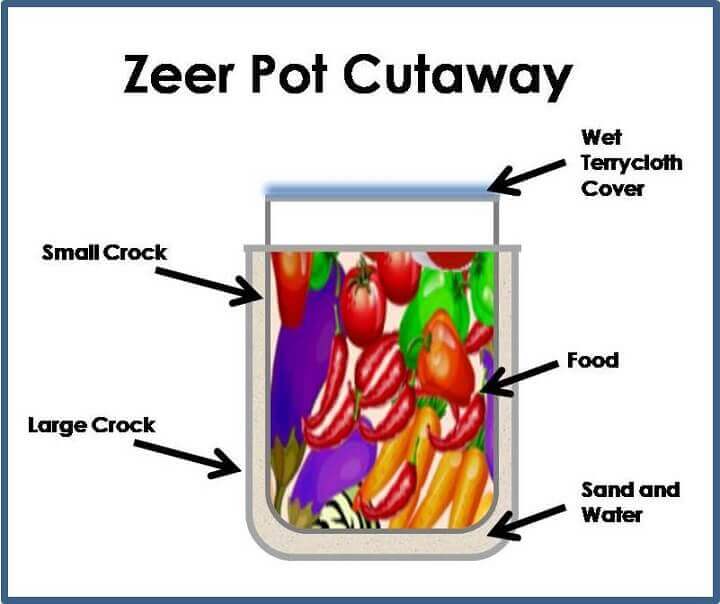
The Zeer pot has been around for thousands of years. It first emerged in the Middle-east where desert temperatures made refrigeration a challenging task. It’s basically a pot in a pot with a wet rag over the top although there’s a little more to it. It uses evaporative cooling to keep things cool.
We’re going to use two crock pots and some sand to make an effective cooling system for food. And this is another solution that’s best kept in the basement or the coolest spot you can find.
Supplies:
- A large crock
- A smaller crock
- Sand
- Water
- Fabric to cover the smaller crock
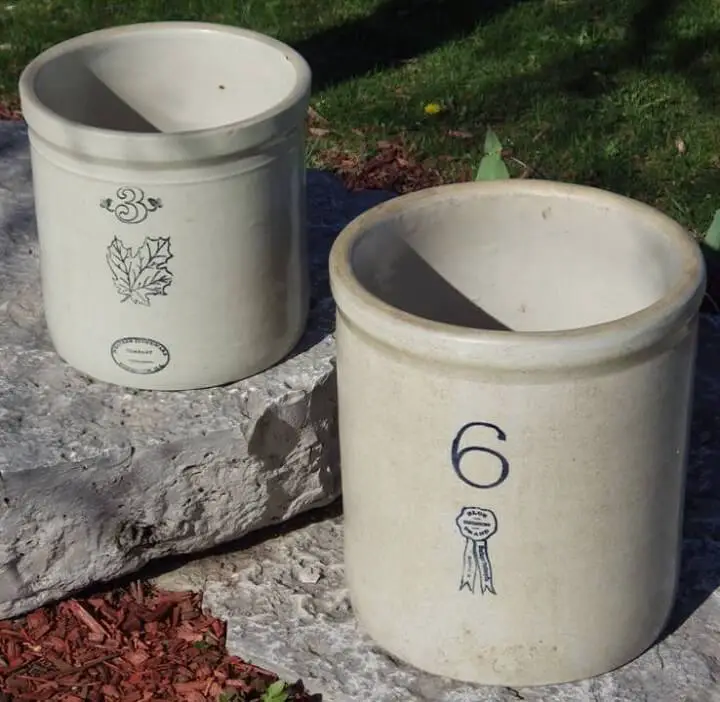
Assembly:
- Pour and level an inch or two of sand in the bottom of the large crock to raise the level of the smaller crock at least an inch above the rim of the large crock.
- Place the smaller crock on the sand and carefully pour sand into the gap between the two pots leaving about an inch of clearance from the top of the large pot.
- Carefully pour water into the sand gap until it just reaches the top of the sand surface.
- Clean up any sand or water that has fallen into the smaller crock.
- Fill the smaller crock with your food items.
- Cover the smaller crock with a wet towel or fabric but try not to cover the sand surface around the larger pot. You may need to trim the towel or fabric into a circle to fit. It’s okay if the fabric touches the sand but you want evaporation of both the wet fabric and the sand to occur. That creates the heat exchange to keep the pots cool.
- Occasionally refill the sand gap with water and wet the towel at least once a day.
Cooler or “Ice-Chest”
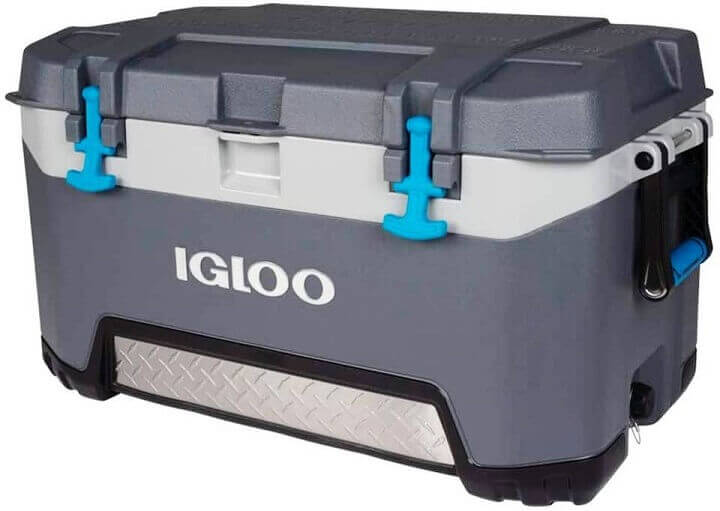
This is a simple solution. No assembly required but it requires a steady supply of ice to keep things cool. The easiest way is to freeze water bottles and store them in the cooler with the food to keep things refrigerated but without a freezer you’re without ice… unless it happens to be winter.

Winter makes it easy to freeze water bottles for your cooler and it doesn’t have to be January. Even nights below freezing in October and March can provide you with ice for your cooler depending on your latitude. Just remember to keep the cooler in the basement if you can.
Winter Kitchen Ice Box
A refrigerator/freezer solution that some off-gridders use is an in-wall, insulated box with shelves exposing a small opening in the back of the box to the outside with an insulated door on the inside facing the kitchen. Some of these actually have the size and shape of a refrigerator cut into a wall in the kitchen.
A small opening in the back of the “ice-box” with a sliding door is used to adjust how much cold outside air is allowed to enter. It requires some special attention to make sure the outside air allowed in is moderated depending on the temperature, but if it’s winter it works.
Under Cabin Floor Metal Box
Another off-grid solution is a scaled down version of a root cellar. It’s usually built under the floor of a cabin without a basement.
A hole is dug in the ground under the cabin about 3 feet square and 2 feet deep and lined with metal to make a box. An insulated and locking metal lid is placed over the top and the in-ground refrigerator is accessed through a trap door in the floor.
Even something as simple as a metal garbage can buried in the ground can provide an acceptable level of refrigeration.
Root cellar
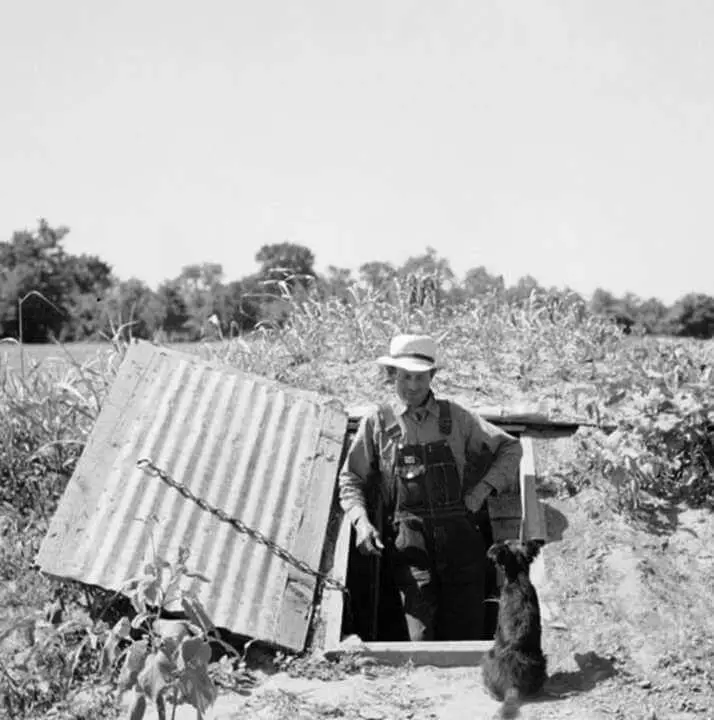
Root cellars were a standard part of pioneer and farm life. Its design is simple, safe and reliable. A root cellar starts with a trench deep enough for someone to stand in or at least stoop. Sizes vary and shelves are usually built in the back and along the sides.
Logs or timbers are placed over the top of the trench and earth is piled over the top enclosing the cellar. A large trap door is often used leading to a short flight of stairs down to the root cellar.
A root cellar is intended as a refrigeration alternative and will not act as a freezer. In fact, one of the touted benefits of a root cellar is that things stored in the root cellar typically won’t freeze in winter.
Metal Box in a Creek or Spring

Anyone with a cold water creek or spring running close to home can place a watertight, metal box in bed of the spring and have a year round refrigerator. In fact, the water in a running spring may actually prevent the contents from freezing in winter (but no guarantees).
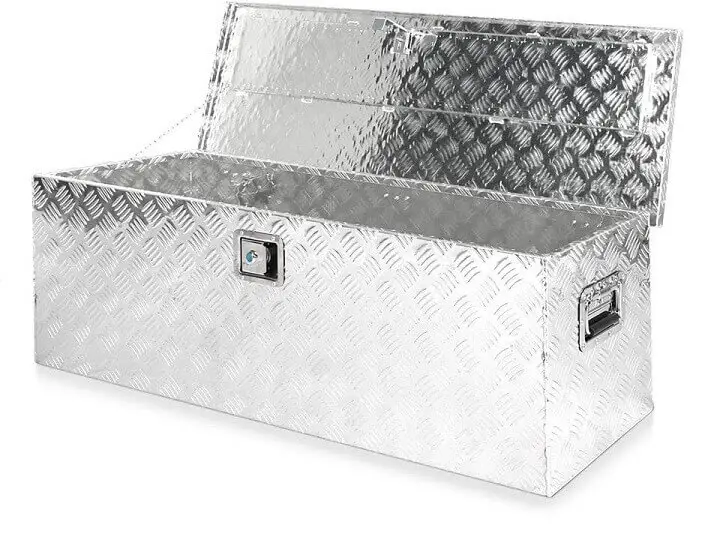
An easy and fast way to do this is to buy one of those locking, metal boxes designed to sit in the back of a pickup truck for tool storage. Most are not only watertight but made of durable stainless steel and the lock will keep any predator at bay – even bears.
More ambitious designs involved a “Spring House” that enclosed a metal or concrete box that was kept constantly cool by the flowing, cold water of the spring or creek.
Propane Refrigerator/Freezer
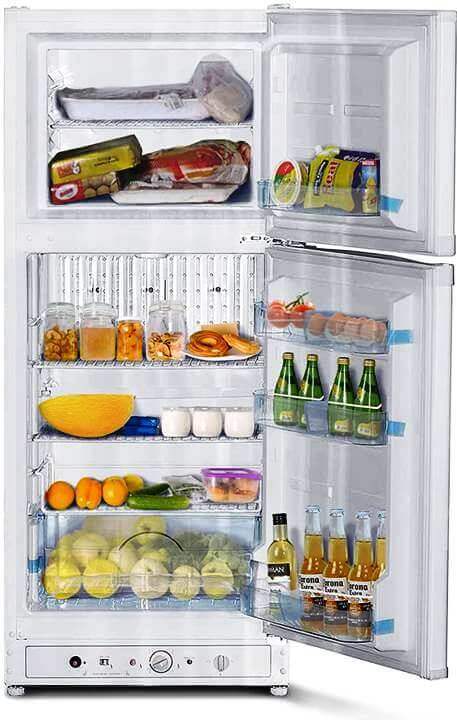
We covered this earlier, but a propane refrigerator/freezer can be a great solution for anyone concerned about a life without refrigeration or planning to live off-the-grid. Access to propane is a constant question but a stockpile of a few tanks (or a home that has a large, whole-house tank) can make this a viable solution, at least until winter returns.
One thing to look at closely whether you’re buying it new or salvaging from a boat’s galley or an RV is if it needs a power source to spark the propane flame. It seems counter-intuitive to refrigerate or freeze something with a flame but that’s how it works.
If it does require power to spark the flame, try to find one that only needs a 12 volt battery. Most salvaged propane fridge/freezers are from RV’s or boats and usually spark with 12 volts.
What About Solar?
It’s possible, but you’ll need a large array of panels and an extensive set of batteries.
Will You Ever Need to Do This?
Maybe, especially if you’re planning for an off-grid lifestyle. But even then, it’s good to know this stuff for your next camping trip. Even a hole in the ground with a wet towel over the top will give you some degree of refrigeration.
Where it becomes more serious is following any disaster especially one that could result in long-term impacts. In fact, it might be worth having a couple of crocks in the basement for a quick Zeer pot assembly… just in case.
Like this post? Don't Forget to Pin It On Pinterest!
You May Also Like:



